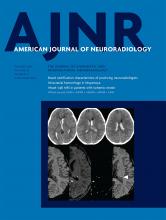Index by author
Hori, M.
- Adult BrainOpen AccessWhite Matter Abnormalities in Multiple Sclerosis Evaluated by Quantitative Synthetic MRI, Diffusion Tensor Imaging, and Neurite Orientation Dispersion and Density ImagingA. Hagiwara, K. Kamagata, K. Shimoji, K. Yokoyama, C. Andica, M. Hori, S. Fujita, T. Maekawa, R. Irie, T. Akashi, A. Wada, M. Suzuki, O. Abe, N. Hattori and S. AokiAmerican Journal of Neuroradiology October 2019, 40 (10) 1642-1648; DOI: https://doi.org/10.3174/ajnr.A6209
Houck, A.L.
- Adult BrainOpen AccessIncreased Diameters of the Internal Cerebral Veins and the Basal Veins of Rosenthal Are Associated with White Matter Hyperintensity VolumeA.L. Houck, J. Gutierrez, F. Gao, K.C. Igwe, J.M. Colon, S.E. Black and A.M. BrickmanAmerican Journal of Neuroradiology October 2019, 40 (10) 1712-1718; DOI: https://doi.org/10.3174/ajnr.A6213
Houdart, E.
- Adult BrainYou have accessEmpty Sella Is a Sign of Symptomatic Lateral Sinus Stenosis and Not Intracranial HypertensionA. Zetchi, M.-A. Labeyrie, E. Nicolini, M. Fantoni, M. Eliezer and E. HoudartAmerican Journal of Neuroradiology October 2019, 40 (10) 1695-1700; DOI: https://doi.org/10.3174/ajnr.A6210
Huda, F.
- LetterYou have accessReply:H.A. Valand, F. Huda and R.K. TuAmerican Journal of Neuroradiology October 2019, 40 (10) E53; DOI: https://doi.org/10.3174/ajnr.A6231
Hui, F.K.
- EDITOR'S CHOICENeurointerventionOpen AccessSafety and Efficacy of Transvenous Embolization of Ruptured Brain Arteriovenous Malformations as a Last Resort: A Prospective Single-Arm StudyY. He, Y. Ding, W. Bai, T. Li, F.K. Hui, W.-J. Jiang and J. XueAmerican Journal of Neuroradiology October 2019, 40 (10) 1744-1751; DOI: https://doi.org/10.3174/ajnr.A6197
Twenty-one consecutive patients with ruptured brain AVMs who underwent transvenous embolization were prospectively followed between November 2016 and November 2018. Complete AVM nidus obliteration was shown in 16 (84%) of 19 patients. One (5%) patient with a small residual nidus after treatment showed complete obliteration at 13-month follow-up. There were 5 hemorrhages and 1 infarction; 4 patients' symptoms improved gradually. Transvenous embolization can be performed only in highly selected hemorrhagic brain AVMs with high complete obliteration rates, but it should not be considered as a first-line treatment.
Huisman, T.A.G.M.
- LetterYou have accessReply:E. Bulut, J. Karakaya, S. Salama, M. Levy, T.A.G.M. Huisman and I. IzbudakAmerican Journal of Neuroradiology October 2019, 40 (10) E62; DOI: https://doi.org/10.3174/ajnr.A6216
Igwe, K.C.
- Adult BrainOpen AccessIncreased Diameters of the Internal Cerebral Veins and the Basal Veins of Rosenthal Are Associated with White Matter Hyperintensity VolumeA.L. Houck, J. Gutierrez, F. Gao, K.C. Igwe, J.M. Colon, S.E. Black and A.M. BrickmanAmerican Journal of Neuroradiology October 2019, 40 (10) 1712-1718; DOI: https://doi.org/10.3174/ajnr.A6213
Irie, R.
- Adult BrainOpen AccessWhite Matter Abnormalities in Multiple Sclerosis Evaluated by Quantitative Synthetic MRI, Diffusion Tensor Imaging, and Neurite Orientation Dispersion and Density ImagingA. Hagiwara, K. Kamagata, K. Shimoji, K. Yokoyama, C. Andica, M. Hori, S. Fujita, T. Maekawa, R. Irie, T. Akashi, A. Wada, M. Suzuki, O. Abe, N. Hattori and S. AokiAmerican Journal of Neuroradiology October 2019, 40 (10) 1642-1648; DOI: https://doi.org/10.3174/ajnr.A6209
Ishak, G.E.
- LetterOpen AccessChimeric Antigen Receptor T-Cell Neurotoxicity Neuroimaging: More Than Meets the EyeJ. Gust and G.E. IshakAmerican Journal of Neuroradiology October 2019, 40 (10) E50-E51; DOI: https://doi.org/10.3174/ajnr.A6184
Iv, M.
- FELLOWS' JOURNAL CLUBAdult BrainYou have accessPerfusion MRI-Based Fractional Tumor Burden Differentiates between Tumor and Treatment Effect in Recurrent Glioblastomas and Informs Clinical Decision-MakingM. Iv, X. Liu, J. Lavezo, A.J. Gentles, R. Ghanem, S. Lummus, D.E. Born, S.G. Soltys, S. Nagpal, R. Thomas, L. Recht and N. FischbeinAmerican Journal of Neuroradiology October 2019, 40 (10) 1649-1657; DOI: https://doi.org/10.3174/ajnr.A6211
Forty-seven patients with high-grade gliomas (primarily glioblastoma) with recurrent contrast-enhancing lesions on DSC-MR imaging were retrospectively evaluated after surgical sampling. Histopathologic examination defined treatment effect versus tumor. Normalized relative CBV thresholds of 1.0 and 1.75 were used to define low, intermediate, and high fractional tumor burden classes in each histopathologically defined group. Performance was assessed with an area under the receiver operating characteristic curve. Mean low fractional tumor burden, high fractional tumor burden, and relative CBV of the contrast-enhancing volume were significantly different between treatment effect and tumor with tumor having significantly higher fractional tumor burden and relative CBV and lower fractional tumor burden. High fractional tumor burden and low fractional tumor burden define fractions of the contrast-enhancing lesion volume with high and low blood volume, respectively, and can differentiate treatment effect from tumor in recurrent glioblastomas. Fractional tumor burden maps can also help to inform clinical decision-making.








